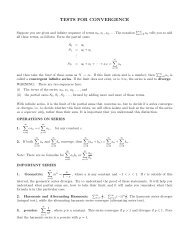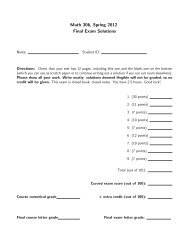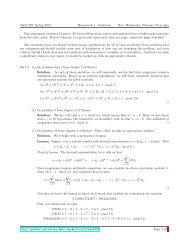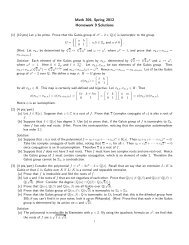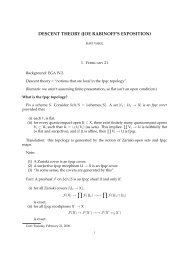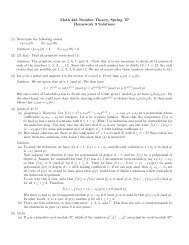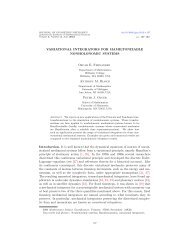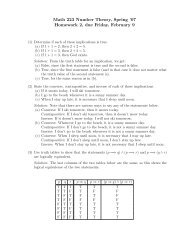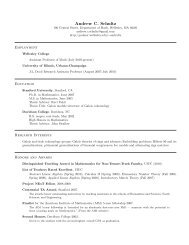Math 223 Number Theory, Spring '07 Homework 10 Solutions
Math 223 Number Theory, Spring '07 Homework 10 Solutions
Math 223 Number Theory, Spring '07 Homework 10 Solutions
Create successful ePaper yourself
Turn your PDF publications into a flip-book with our unique Google optimized e-Paper software.
<strong>Math</strong> <strong>223</strong> <strong>Number</strong> <strong>Theory</strong>, <strong>Spring</strong> ’07<br />
<strong>Homework</strong> <strong>10</strong> <strong>Solutions</strong><br />
(1) Find all quadratic residues modulo 31. (Hint: Find a primitive root modulo 31.)<br />
Solution: It is not hard to see that, for example, 3 is a primitive root modulo 31. Then all the quadratic<br />
residues modulo 31 are 3 2 , 3 4 , ..., 3 30 (mod 31).<br />
(2) Determine whether each of the following congruences has a solution. All of the moduli are primes.<br />
(a) (24.1(a)) x 2 ≡ −1 (mod 5987)<br />
(b) (24.1(b)) x 2 ≡ 6780 (mod 6781)<br />
(c) x 2 ≡ 8 (mod 53)<br />
(d) x 2 + 14x + 47 ≡ 0 (mod 337) (Hint: Complete the square.)<br />
Solution:<br />
(a) Since 5987 ≡ 3 (mod 4), this congruence does not have a solution by Quadratic Reciprocity Part 1.<br />
(b) This congruence can be rewritten as x 2 ≡ −1 (mod 6781). Since 6781 ≡ 1 (mod 4), there is a solution<br />
by Quadratic Reciprocity Part 1.<br />
(c) Since 53 ≡ 5 (mod 8), we have<br />
( ( ) ( ) ( ) ( ) ( ( 8 2<br />
3 2 2 2 2 2<br />
= =<br />
= · 1 = = −1<br />
53)<br />
53 53 53 53 53)<br />
53)<br />
so the congruence has no solutions by Quadratic Reciprocity Part 2.<br />
(d) Since x 2 + 14x + 47 = (x + 7) 2 − 2, the question is whether the congruence (x + 7) 2 ≡ 2 (mod 337)<br />
has a solution x + 7. Since 337 ≡ 1 (mod 8), the solution exists by Quadratic Reciprocity Part 2.<br />
Subtracting 7 from this solution gives a solution x to the original congruence.<br />
(3) (parts( of 25.1) ) Use the Law ( of)<br />
Quadratic Reciprocity to compute the following Legendre symbols.<br />
85<br />
29<br />
(a)<br />
(b)<br />
<strong>10</strong>1<br />
541<br />
Solution:<br />
(a) Since 85 factors as 5 · 17 and since <strong>10</strong>1 ≡ 1 (mod 4), we have<br />
( ) ( ) ( ) ( ) ( ) ( ) ( )<br />
85 5 17 <strong>10</strong>1 <strong>10</strong>1 1 16<br />
=<br />
=<br />
=<br />
= 1 ·<br />
<strong>10</strong>1 <strong>10</strong>1 <strong>10</strong>1 5 17 5 17<br />
But since 17 ≡ 1 (mod 4), we have<br />
( ) 85<br />
=<br />
<strong>10</strong>1<br />
( ) 16<br />
=<br />
17<br />
( ) ( 17 1<br />
= = 1.<br />
16 16)<br />
( ) 16<br />
=<br />
17<br />
(b) Both 29 and 541 are primes. Since 29 ≡ 1 (mod 4), we have<br />
( ) ( ) ( ) ( ) ( ) ( ) ( 29 541 19 29 <strong>10</strong> 2 5<br />
= = = = =<br />
.<br />
541 29 29 19 19 19 19)<br />
Since 19 ≡ 3 (mod 8), and since 5 ≡ 1 (mod 4), we get<br />
( ) ( ) ( ( 29<br />
19 4 5<br />
= −1 · = − = −<br />
541<br />
5 5)<br />
4)<br />
( 1<br />
= − = −1.<br />
4)<br />
( ) 16<br />
.<br />
17<br />
(4) Let p be an odd prime and let a, b ∈ Z be inverses modulo p. Prove that if a is a quadratic residue modulo<br />
p, then so is b.
(<br />
Solution: Suppose that a<br />
p)<br />
= 1. Then if ab ≡ 1 (mod p), we have<br />
( ( ) ( ) ( ( 1 ab a b b<br />
1 = = =<br />
=<br />
p)<br />
p p p)<br />
p)<br />
as desired. The first equality is true since 1 is always a quadratic residue.<br />
( 3<br />
(5) Suppose p is a Mersenne prime greater than or equal to 5. Prove that = −1.<br />
p)<br />
Solution: Let p = 2 q − 1 be a Mersenne prime for some prime q ≥ 3. Note that p ≡ 3 (mod 4). Thus<br />
( 3<br />
( ( p 2<br />
= − = −<br />
p)<br />
3) q ) (<br />
− 1 (−1) q ) ( ) ( ) (<br />
− 1 −1 − 1 −2 1<br />
= −<br />
= −<br />
= − = − = −1.<br />
3<br />
3<br />
3<br />
3 3)<br />
(6) Let p be a prime. Prove that, if p ≡ 3 (mod 8) and p−1<br />
2<br />
is a prime, then p−1<br />
2<br />
is a quadratic residue mod p.<br />
Solution: Since p ≡ 3 (mod 8), then p−1<br />
2<br />
≡ 1 (mod 4) and p ≡ 1 (mod p−1<br />
2<br />
), so<br />
( ) ( ) ( )<br />
p−1<br />
2<br />
= = = 1.<br />
p<br />
p<br />
p−1<br />
2<br />
(7) Let p be a prime with p ≥ 5 and let k = p−1<br />
2 . Let a 1, a 2 , ..., a k ∈ {1, 2, ..., p − 1} be the quadratic residues<br />
mod p. Prove that p divides ∑ k<br />
i=1 a i.<br />
Solution: It suffices to show that this sum is congruent to 0 mod p. If g is a primitive root mod p, then the<br />
quadratic residues are given by g 2 , g 4 , ..., g p−1 . Let M = g 2 +g 4 +· · ·+g p−1 . Note that g 2 M ≡ M (mod p),<br />
so (g 2 − 1)M ≡ 0 (mod p). However, since p > 3, we have g 2 ≢ 1 (mod p) since g is a primitive root, so it<br />
must be that M ≡ 0 (mod p).<br />
1<br />
p−1<br />
2



